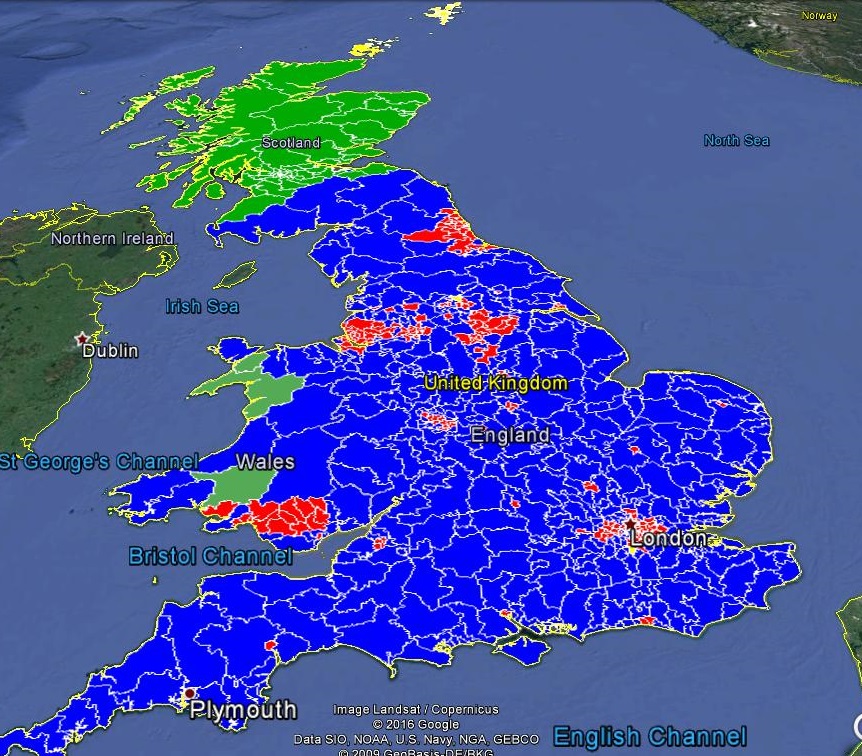The
Conservatives 48% 397 seats
Labour 31% 177 seats

The Conservatives are up 10 points since 2015 and would gain 65 seats – however in the first polls after the election was called they were on a similar figure but were gaining 125 seats. The difference this time is that Labour have closed the gap somewhat from 23 points to 17 points. They would gain particularly amongst older voters, working-class voters and voters outside London and the South. By contrast, the vote amongst younger voters has remained static. Their support amongst Remainers has decreased by 5 points during the campaign – their support amongst Leavers has increased by 4 points. The Tories would win 127 of the 159 most middle-class constituencies, compared to 38 of the 139 most working-class constituencies. They also win 194 of the 220 constituencies with the Oldest age profile, compared to 29 of the 122 constituencies with the youngest age profile.
Labour have held onto their younger vote – in fact they have significantly increased it, but lose amongst older voters. The Tories are still ahead of them in every region bar London (where they are now comfortably ahead of the Tories) – but a rise in their vote in Wales suggests they could take a third of the seats, which is an improvement on the near-complete wipeout suggested by previous polls. In the North, the Tories are narrowly ahead of Labour on votes, but Labour are projected to take narrowly more seats. Labour would win just 25 of the 159 most middle-class constituencies, compared to 83 of the 139 most working-class constituencies. They win only 10 of the 220 constituencies with the oldest age profile, compared to 83 of the 122 constituencies with the youngest age profile.
The Liberal Democrats have fallen two pints since the start of the campaign, but are still one point ahead of their 2015 figure. However, they are in danger of losing some of their 8 seats. They fare better amongst middle-class voters, and 5 out of every 6 Liberal Democrats are Remain voters, due partly to a small influx of Remain voters from other parties, but more because of an exodus of 2015 Liberal Democrat voters who voted LEAVE – it seems only 2 out of every 5 intend to stick with the LibDems, and a similar number intend to vote for the Tories.
UKIP entered the campaign with just over half their 2015 vote and now have as little as a third of it. The majority of 2015 UKIP voters now say they are going to vote Conservative. They do best amongst working-class voters, and the vast majority of UKIPers are Leave voters.
The SNP would still retain a huge majority of the seats in Scotland, even though their vote is down somewhat.
The Conservatives been very successful in retaining their 2015 voters, with 9 out of 10 saying there are sticking with them. In addition nearly half of 2015 UKIP voters and nearly a quarter of 2015 Liberal Democrat voters (and 1 in ten 2015 Labour voters) are now intending to vote for the Conservatives. Of Particular interest is that, despite the fact that the Conservatives are implementing Brexit, they are managing to hang on to more than 5 out of 6 of their 2015 voters who voted REMAIN in 2016 (source : ICM polls). This compares to Labour only currently retaining 2 out of 3 of their LEAVE voters, and the Liberal Democrats only retaining 1 out of 3 of their Leave Voters.
In fact the Liberal Democrat support base seems to be in considerable flux – only half of those currently intending to vote LibDem voted for the party in 2015 (one in 6 are former Tory voters, 1 in 4 are former Labour voters) – on the other side 2 out of every 5 of their 2015 voters are now voting for either the Conservatives or Labour (splitting slightly in favour of the former).
One of the more surprising findings in ICM polls is that the Conservatives are outpolling Labour by 46% to 35% in Labour marginal seats. However a similar analysis by YouGov (which returned a 9 point lead for the Tories in Labour marginals on National Voting intentions) found that when respondents were asked about their constituency voting intention, the Conservative lead was cut to 2 points.
According to PanelBase figures, nearly 4 out of 5 voters who gave a party preference said they have definitely made up their mind compared to 1 out of 5 who said they might change it. Only 1 out of 6 Tory voters said they might switch, compared to 2 out of 5 Liberal Democrats.
At the time of the Brexit Referendum The Tories were virtually tied with UKIP amongst Leave voters – they started this campaign 50 points ahead of them, and have now moved sixty points ahead reflecting polling showing that the bulk of 2015 UKIP voters are now intending to vote Conservative. By contrast, The Tories started the campaign again virtually tied with Labour amongst Remain Voters – but have now fallen 15 points behind them amongst this cohort (a similar margin to that at the the time of the Brexit vote).
You can download the report : UK May 10 to May 15